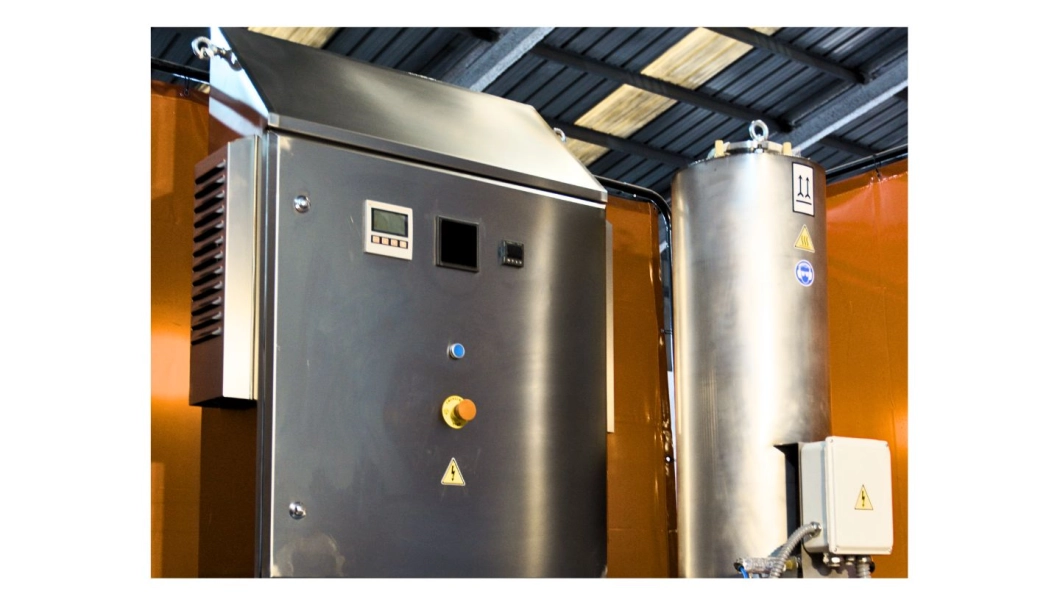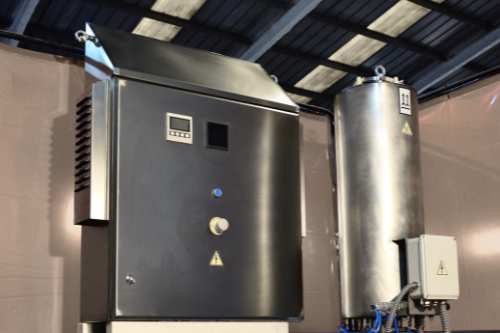Mon, 26 May 2025 16:58:42 +0200

Inside the flow cell, the liquid or sludge undergoes a precisely controlled sonication process. The entire fluid volume passes through the active cavitation zone, strategically located under the sonotrode, where it receives homogeneous ultrasonic treatment. Once past this zone of maximum intensity, the fluid continues its journey toward the system outlet. Depending on process requirements, this ultrasonic exposure can be applied once or repeated in multiple cycles to achieve more in-depth results.
This process triggers a series of physicochemical effects that can be used in a wide variety of applications: disinfection, removal of biological contaminants, degradation of organic compounds, cell disintegration, and much more.
DISCOVER OUR ULTRASONIC FLOW CELLS
The versatility of this technology allows it to be implemented in different types of treatment, whether in industrial, urban, agricultural, or drinking water. The main uses of ultrasonic flow cells are detailed below:
1. Liquid disinfection
Ultrasonic waves generate cavitation, a phenomenon that destroys the cell membranes of bacteria, viruses, and pathogenic microorganisms. This process is highly effective as a disinfection system without the use of chemicals, which prevents the generation of harmful byproducts such as trihalomethanes.
2. Germ and bacteria elimination
Thanks to the mechanical action of microbubbles and the intense vibration of the medium, ultrasonic flow cells eliminate common germs such as Escherichia coli, Salmonella, Legionella, among others. This technique can be used in industries that require microbiologically safe water, such as food, pharmaceutical, and cosmetics.
3. Parasite and protozoa elimination
Ultrasonic flow cells have proven effective against parasites such as Giardia and Cryptosporidium, which typically resist conventional chlorine treatments. Cavitation mechanically disintegrates them, significantly improving the quality of the treated water.
4. Reduction of organic load (COD/BOD)
By applying ultrasound, complex organic molecules present in water are broken down into simpler compounds, facilitating their removal in subsequent stages. This reduces Chemical Oxygen Demand (COD) and Biological Oxygen Demand (BOD), two key indicators in wastewater treatment.
5. Improvement of biological processes and pretreatments
The use of ultrasonic flow cells as pretreatment enhances the efficiency of biological processes, such as sequential biological reactors (SBR) or activated sludge. This is due to the rupture of cell walls in the sludge, which releases nutrients and improves the digestibility of the material by beneficial microorganisms.

Chemical-Free
One of the main advantages of ultrasonic flow cells is that they do not require the use of chemical reagents, which eliminates associated costs and unwanted secondary waste.
Improved Overall System Efficiency
Ultrasonic treatment can be applied as a stand-alone system or as a complementary step to improve the efficiency of conventional processes (filtration, coagulation, decantation, oxidation, etc.).
Reduced Operating Costs
Less chemical use, less need for filtration, and longer life of auxiliary equipment translate into direct savings in maintenance and consumption.
Environmentally Friendly Technology
By reducing the use of harsh chemicals and eliminating contaminants without generating additional waste, ultrasonic flow cells contribute to more sustainable and environmentally friendly production.
Compact, Modular, and Scalable
This technology is perfectly suited to small, medium, and large plants. Its compact and modular design allows for easy integration without major modifications to existing infrastructure.
REQUEST MORE INFORMATION ABOUT OUR LIQUID TREATMENT FOR THE FOOD INDUSTRY
Ultrasonic flow cells represent a revolutionary solution for water and liquid treatment in modern industry. Their ability to disinfect, eliminate germs, degrade organic matter, and reduce the use of chemicals makes them an indispensable tool for any company committed to efficiency, water quality, and sustainability.
At DCM Ultrasonic, we develop solutions tailored to every need. If your company needs to optimize water or liquid treatment in its processes, we are ready to help you with the best ultrasonic technology on the market.
Contact us at info@dcmultrasonic.com and take the next step toward smarter and greener water management.

News
Water and liquid treatment with flow cells
26 May de 2025
Efficient water management is a growing challenge in virtually all industrial sectors. Proper liquid treatment in process plants, wastewater, process water, or drinking water is not only a regulatory requirement, but also an opportunity to improve sustainability, reduce operating costs, and ensure production safety. In this context, ultrasonic flow cell technology is positioned as an innovative, clean, and highly effective tool for treating water and liquids in their various phases.Inside the flow cell, the liquid or sludge undergoes a precisely controlled sonication process. The entire fluid volume passes through the active cavitation zone, strategically located under the sonotrode, where it receives homogeneous ultrasonic treatment. Once past this zone of maximum intensity, the fluid continues its journey toward the system outlet. Depending on process requirements, this ultrasonic exposure can be applied once or repeated in multiple cycles to achieve more in-depth results.
What is an ultrasonic flow cell?
An ultrasonic flow cell is a device designed to apply high-frequency sound waves (usually between 20 kHz and 100 kHz) to a circulating liquid, such as water. The cell is equipped with ultrasonic transducers that generate controlled cavitation within the fluid as it flows through the system.This process triggers a series of physicochemical effects that can be used in a wide variety of applications: disinfection, removal of biological contaminants, degradation of organic compounds, cell disintegration, and much more.
DISCOVER OUR ULTRASONIC FLOW CELLS
Applications of ultrasonic flow cells in liquid treatment
The versatility of this technology allows it to be implemented in different types of treatment, whether in industrial, urban, agricultural, or drinking water. The main uses of ultrasonic flow cells are detailed below:
1. Liquid disinfection
Ultrasonic waves generate cavitation, a phenomenon that destroys the cell membranes of bacteria, viruses, and pathogenic microorganisms. This process is highly effective as a disinfection system without the use of chemicals, which prevents the generation of harmful byproducts such as trihalomethanes.
2. Germ and bacteria elimination
Thanks to the mechanical action of microbubbles and the intense vibration of the medium, ultrasonic flow cells eliminate common germs such as Escherichia coli, Salmonella, Legionella, among others. This technique can be used in industries that require microbiologically safe water, such as food, pharmaceutical, and cosmetics.
3. Parasite and protozoa elimination
Ultrasonic flow cells have proven effective against parasites such as Giardia and Cryptosporidium, which typically resist conventional chlorine treatments. Cavitation mechanically disintegrates them, significantly improving the quality of the treated water.
4. Reduction of organic load (COD/BOD)
By applying ultrasound, complex organic molecules present in water are broken down into simpler compounds, facilitating their removal in subsequent stages. This reduces Chemical Oxygen Demand (COD) and Biological Oxygen Demand (BOD), two key indicators in wastewater treatment.
5. Improvement of biological processes and pretreatments
The use of ultrasonic flow cells as pretreatment enhances the efficiency of biological processes, such as sequential biological reactors (SBR) or activated sludge. This is due to the rupture of cell walls in the sludge, which releases nutrients and improves the digestibility of the material by beneficial microorganisms.

Benefits of Applying Ultrasound in Liquid Treatment
Chemical-Free
One of the main advantages of ultrasonic flow cells is that they do not require the use of chemical reagents, which eliminates associated costs and unwanted secondary waste.
Improved Overall System Efficiency
Ultrasonic treatment can be applied as a stand-alone system or as a complementary step to improve the efficiency of conventional processes (filtration, coagulation, decantation, oxidation, etc.).
Reduced Operating Costs
Less chemical use, less need for filtration, and longer life of auxiliary equipment translate into direct savings in maintenance and consumption.
Environmentally Friendly Technology
By reducing the use of harsh chemicals and eliminating contaminants without generating additional waste, ultrasonic flow cells contribute to more sustainable and environmentally friendly production.
Compact, Modular, and Scalable
This technology is perfectly suited to small, medium, and large plants. Its compact and modular design allows for easy integration without major modifications to existing infrastructure.
REQUEST MORE INFORMATION ABOUT OUR LIQUID TREATMENT FOR THE FOOD INDUSTRY
Ultrasonic flow cells represent a revolutionary solution for water and liquid treatment in modern industry. Their ability to disinfect, eliminate germs, degrade organic matter, and reduce the use of chemicals makes them an indispensable tool for any company committed to efficiency, water quality, and sustainability.
At DCM Ultrasonic, we develop solutions tailored to every need. If your company needs to optimize water or liquid treatment in its processes, we are ready to help you with the best ultrasonic technology on the market.
Contact us at info@dcmultrasonic.com and take the next step toward smarter and greener water management.
